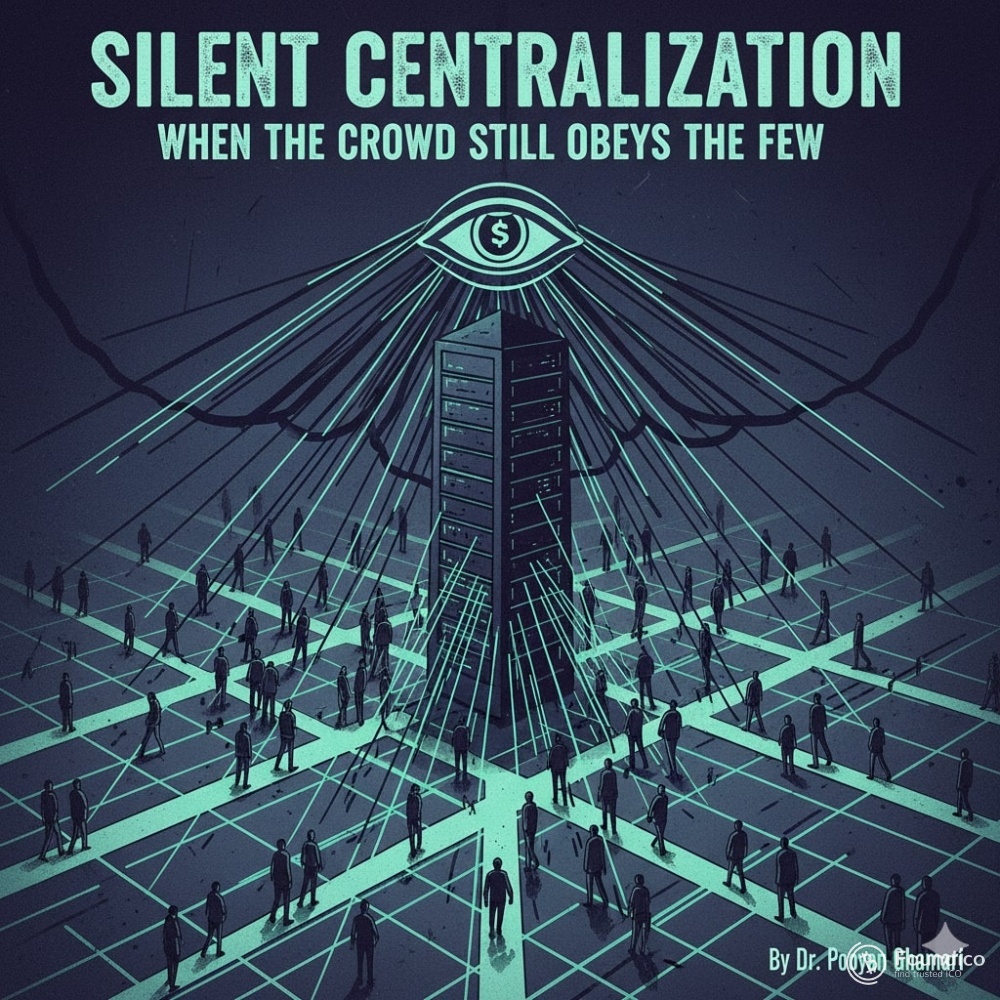Silent Centralization: When the Crowd Still Obeys the Few

By Dr. Pooyan Ghamari, Swiss Economist and Visionary
In the grand narrative of technological progress, we often champion the ideals of decentralization, empowerment, and democratic participation. We laud the rise of cryptocurrencies, open-source movements, and social platforms as evidence of a shift away from hierarchical control. Yet, beneath the veneer of distributed networks and community-driven initiatives, a subtle and insidious phenomenon persists: Silent Centralization.
This isn't the overt, iron-fisted centralization of old; it’s a more sophisticated beast, one that thrives in the shadows of seemingly decentralized systems. It's when the crowd, despite having the theoretical tools for autonomy, still unconsciously or tacitly obeys the few. It’s a centralization not of explicit command, but of influence, infrastructure, and information.
The Illusion of Distributed Power
Consider the internet itself. Designed to be a robust, distributed network, it has increasingly coalesced around a handful of tech giants. Search engines, social media platforms, cloud providers—these are the modern-day gatekeepers, wielding immense power over what we see, how we communicate, and where our data resides. Even if we technically "own" our websites, their visibility and reach are often dictated by these few.
The same insidious pattern can be observed in nascent decentralized movements:
1. Infrastructure Bottlenecks: Many supposedly decentralized applications (dApps) and even entire blockchain networks still rely on a small number of centralized infrastructure providers. Whether it’s hosting services, node operators, or critical API endpoints, a single point of failure or control can silently undermine the entire decentralized premise. If a few entities control the pipes, they effectively control the flow, regardless of what's inside.
2. Development and Governance Cartels: While projects may claim to be community-governed, a disproportionate amount of influence often remains with the founding team, core developers, or early investors. They hold the keys to intellectual property, have the deepest understanding of the code, and often control significant voting power through large token holdings. Community "input" can become a mere formality if the underlying power structure remains imbalanced.
3. Information and Narrative Control: In a world saturated with information, attention itself becomes a centralized commodity. Key influencers, media outlets, and thought leaders can subtly shape public opinion, guide investment trends, and effectively control the narrative around decentralized technologies. When information filters through a few dominant voices, the crowd, even a technically empowered one, is still being led.
4. Economic Centralization (Whale Problem): Many decentralized protocols distribute tokens to represent ownership and governance. However, if a significant percentage of these tokens are concentrated in the hands of a few "whales," the theoretical distribution of power becomes practically centralized. These large holders can sway critical votes, manipulate markets, and exert undue influence over the project's direction, making the "one token, one vote" model less democratic than it appears.
The Dangers of Silent Centralization
The silent nature of this centralization makes it particularly dangerous. It lulls participants into a false sense of security, believing they are part of a truly distributed system, while the levers of power remain firmly in the grip of the few. This can lead to:
-
Vulnerability to Censorship and Control: If critical infrastructure is centralized, it can be pressured or shut down.
-
Reduced Innovation: Centralized influence can stifle diverse ideas and favor initiatives that benefit the powerful few.
-
Erosion of Trust: When the promise of decentralization is unfulfilled, disillusionment sets in, undermining the very principles these technologies aim to uphold.
-
Market Manipulation: Concentrated power allows for easier manipulation of prices and outcomes.
Breaking the Silence: A Call for True Decentralization
To truly escape the old paradigms of control, we must actively combat silent centralization. This requires:
-
Auditing Infrastructure Dependencies: Projects and users must rigorously examine their reliance on centralized services and actively seek out decentralized alternatives for hosting, data storage, and network access.
-
Empowering Diverse Development: Fostering truly diverse developer communities and funding mechanisms that reduce reliance on a core few.
-
Promoting Critical Media Literacy: Encouraging individuals to seek out diverse information sources and to critically evaluate narratives, rather than passively consuming content from a few dominant platforms or influencers.
-
Designing for Economic Distribution: Protocols need to be designed with mechanisms that encourage broader token distribution and mitigate the concentration of power in the hands of a few large holders. This could include quadratic funding, time-locked voting, or other novel governance models.
-
Active Community Participation: Decentralization is not a passive state; it requires active and informed participation from the community to hold power accountable and ensure truly distributed decision-making.
Silent centralization is a testament to the enduring human tendency towards hierarchy and control. As we build the future, we must be perpetually vigilant, ensuring that our innovative tools for decentralization are not silently subverted, leaving the crowd to still obey the few, just in a new, more technologically sophisticated cage. The promise of true freedom lies in consciously and continuously fighting for genuine distribution of power, not just its illusion.
